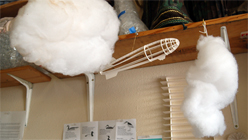Did you give them tools to break out of the cell?
TH: The first group worked together and there were seven of them, so I didn’t give them any tools. The second group was kind of punk or post-hippy kids who were looking for a job. I picked them up in the parking lot of the Home Depot in Emeryville. There were three of them, so I gave them a wooden pole so they could destroy the wall a little bit more easily. There was a sense of progression in terms of the tools they could use. The final tool was a chair, but the person had to sit there alone. She was by herself. She was a prostitute I hired on San Pablo Avenue. A prostitute needs to work alone all the time, so I kind of liked that situation. She used the chair to destroy the cell. I talked with all of the groups and documented them, and that’s what you see at the gallery. The debris from the cells, and the videos.

From looking at some of your past projects, it seems you are very interested in things that fly.
TH: Yes, I am. The birds and airplanes. I can rationalize it by saying I have this visceral feeling. It’s not like I want to fly or be a pilot, but I’m interested in the way something heavy can fly; that kind of contradiction. And then I’ve been trying to define the idea of lightness and what it means for me, personally. Lightness for me is a contradictory idea where something can look light and fly, or float, but also contains some kind of heaviness in it. That’s why I’ve been making structures of flying devices, just the skeleton of it. It’s a flying object but it can still represent or evoke the feeling of heaviness, too.


If your art had a soundtrack, what would it be?
TH: I have a strong belief that the idea of background music is really wrong. I hate using music in the background. It would definitely need to be composed along with my work. Music, for me, is so important. When I hear a sound, I start listening. I can’t have it in the background of something else. When they start playing music in a movie I’ll think, “Stop! Stop, I’m watching this movie.” They show their desire to agitate us. Now it’s sad, now it’s fun. Don’t tell us how we feel! That’s why I don’t like it. But if it’s composed well and used in a clever or smart way, that’s good. I like the soundtrack of Sokurov’s movie, The Sun. It’s the story of a Japanese emperor, and the soundtrack is used really beautifully.


How does the news media influence your work?
TH: The first thing I’ll say is that I hate TV. I used to work for a TV broadcasting station, which made me hate it. I don’t know why an individual person needs to have 300 channels. They use such a huge amount of money for each program, it’s such a waste. I like radio because I can limit how much information I’m getting. I always listen to KQED, and I’m not just saying that because you are here. I also listen to KCSM Jazz radio. I read Internet newspapers so much, but I sometimes force myself to stop because too much information keeps coming in.
I can’t help thinking about the insensitivity of the media. For example, a few days ago, the New York Times posted an interactive media piece about Japan’s earthquake and tsunami and there was a slider function that allowed you to move the image of the Tsunami site from before to after. That made me so emotional. I couldn’t stand it. So many people died on that site; it’s horrible. That was before and after their death. And they force us to slide it. It’s definitely very important to know what’s really going on, and how horrible the situations are. But don’t let us move it like that. Things are naively presented to us, and we are conditioned by them. I hate that aspect of the media.
I’m organizing an art auction event to raise funds for Japan. I have so many friends here who are artists, and I am asking them to donate artworks. There are many places you can donate money right now. And in the coming 5-6 years they will really need money when they start to rebuild things. We all need to donate.



















